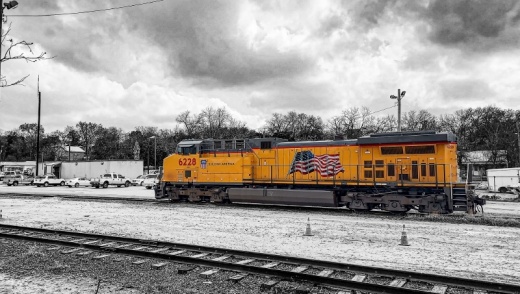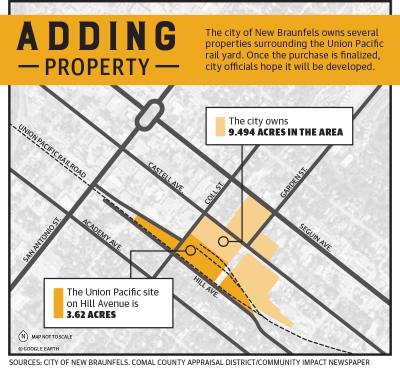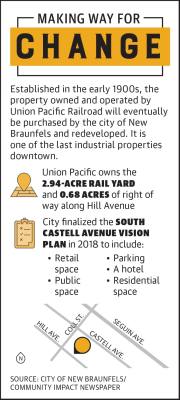This recently approved agreement has paved the way for future developments in the downtown area following several years of negotiations between Union Pacific and area officials, said Jeff Jewell, director of economic and community development for the city.
Through the deal, the city will also fund engineering and design costs associated with constructing a replacement facility for Union Pacific to relocate its operations to an unincorporated part of Comal County.
“This is really merely the beginning of a process that has been negotiated with Union Pacific since early 2020,” Jewell said. “Transitioning this older, industrial use out of the area has numerous benefits for the community at large.”
City officials have been working to relocate public works facilities and underused industrial sites in the downtown area to other parts of the city to make way for new development in the city’s core, he said.
Moving the rail yard operations to a new location would allow work to begin on the city’s South Castell Avenue Visioning Plan, Mayor Rusty Brockman said during an April 11 meeting. The plan was adopted in 2018 and created development guidelines for approximately 10 acres in the downtown area.
“We are certainly a lot closer and a lot farther down the track than we ever thought we might be at this point,” Brockman said at the meeting. “It’s been a long road to be able to make these kinds of strides.”
A deal years in the making
The rail yard has been in operation for more than a century, according to city documents, and currently serves as a Union Pacific Railroad office, switchyard and refueling station.
Plans for the city to purchase the site have been a subject of conversation for many years as officials sought to make the area more cohesive with the rest of downtown, Jewell said.
“Union Pacific and the city of New Braunfels have discussed this idea at a high level several times for more than a decade, but discussions became more serious over the last 3-4 years,” said Max Jaixen, senior manager of communications for Union Pacific Railroad.
To facilitate the purchase of the property, Jewell said the city and economic development corporation agreed to fund the design and construction of a new rail office at Union Pacific Railroad’s Corbyn Yard property located off of Bunker Street in an unincorporated area of Comal County.
The NBEDC receives 25% of sales tax revenue collected by the city that is then made available to support community development projects and create incentives for development, Jewell said.
“We have to basically absorb all of Union Pacific’s costs. ... They have no incentive, basically, to move out,” Jewell said. “We’ve discussed it enough with elected officials and appointed officials that they feel like the expenditure in the long-term is worth it.”
Of the $2.18 million expenditure approved by City Council from the NBEDC, $1.5 million will be used to purchase the land while the remaining $680,000 will be used for studying the feasibility of relocating Union Pacific Railroad’s operations to Corbyn Yard, designing a new facility and surveying the downtown property.
“A preliminary engineering agreement will allow Union Pacific to begin determining the viability of relocating those operations,” Jaixen said. “It also allows the city to perform an environmental evaluation of our property in downtown New Braunfels. The success of this entire project hinges on the results of these efforts.”
The deal gives the city the ability to exit the agreement if costs become too high or if the city’s environmental analysis uncovers significant issues with the property, Jewell said.
Construction costs for the new rail yard facility are estimated to be $4 million and are not included in the initial agreement, he said. A new agreement following the design and survey phase would cover the building itself.
“Once the final design is kind of nearing completion, at that point [Union Pacific Railroad] will have a pretty good idea about what that cost for those facilities would be,” Jewell said. “We anticipate wrapping this by the beginning of 2025.”
Plans for South Castell Avenue
In 2018, the city adopted the South Castell Avenue Visioning Plan after several years of planning and community input regarding the redevelopment of approximately 10 acres surrounding the New Braunfels Civic and Convention Center, including the Union Pacific property.
“We want to acquire that property so that we can redevelop that site in the downtown area [and] continue to invest in our downtown,” New Braunfels City Manager Robert Camareno said during the April 11 council meeting. “This is one of several puzzles that had to fall into place in order for us to be able to implement the South Castell vision.”
Douglas Architects was contracted to study and analyze potential ways the area could be redeveloped and collaborated with area stakeholders to outline a framework for the type of developments that would be the most beneficial for the city.
Community members met over the course of six public meetings to share their input regarding the redevelopment plan, Douglas Architects President Andrew Douglas said.
Each of the options presented in the final plan incorporate residential, retail, civic, hotel and parking components at varying densities, he said.
“In the end, the vision plan wasn’t a master plan,” Douglas said. “The goal here was to tee this up and make it attractive to the developer community and [include] the input of the citizens of New Braunfels, the city, all the major stakeholders in New Braunfels, so that they would understand where the community’s head’s at, what they’re looking for [and] what they would like to see happen.”
Establishing a development framework, evaluating the site’s economic potential and working to relocate Union Pacific Railroad’s fueling facility helps to make the property more appealing to developers while allowing the city to set guidelines for what would be most desirable in the downtown area, Jewell said.
“We’re trying to reduce risk for the private sector so the private sector can bring in the bulk of the money for redevelopment of the site, whatever that ends up looking like,” he said.
Community input
As the deal with Union Pacific Railroad moves forward and pushes the vision plan forward, many residents agree that removing the rail yard from downtown will be a benefit to the city.
“The potential for investment and economic impact there is considerable,” said Chris Snider, whose family owns several area businesses, including Krause’s Cafe on South Castell Avenue.
Because the rail yard and surrounding properties owned by the city are relatively undeveloped, Snider said future building projects have the potential to serve various community needs.
“Cleaning up the property [is] the obvious first step, but downtown has some needs that have been identified, such as improved alternative pedestrian access, green space [and] parking,” he said. “There can be significant impact for the better on really the entirety of downtown because they’re gonna have great connectivity.”
However, some residents have raised concerns that high-density development in the area could add to traffic or substantially change the appearance of downtown.
“It’s in the wrong spot to do this sort of scale,” said David Warmke, a resident who participated in many of the public meetings during the creation of the South Castell Avenue Vision Plan. “It needs to be developed, but it needs to be developed low density, and I think it needs to be sold. ... You get a good developer that you trust and then turn them loose with constraints as opposed to this partnership thing where we’re directing what we want.”
Officials said the goal of any redevelopment downtown is to meet the needs of a growing community without detracting from its character.
“The South Castell Area Master Plan was to establish basically an overall development vision for what that property should ultimately be,” Jewell said. “It should be catalytic; it should be based in market realities; it should offer something to visitors and residents alike.”









